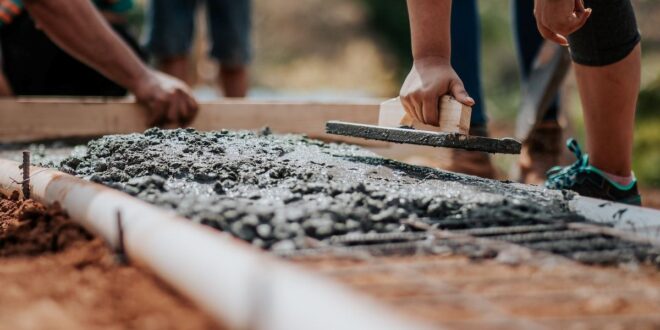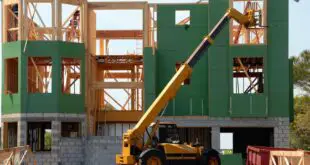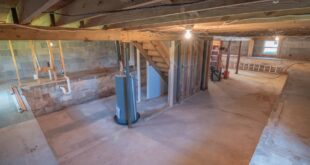Quickrete is a popular building material nowadays, as it sets faster and is easier to use for smaller projects. However, since it may not work similarly to regular concrete, many also wonder how long Quikrete takes to dry.
It generally takes around 20 minutes to 48 hours to 40 minutes for Quikrete to set, depending on the Quikrete mix you are using. However, for Quickrete to achieve its full load-bearing capacity, you should allow it up to 28 days to fully cure and strengthen.
This article describes how long Quikrete takes to dry. Aside from that, we also discuss how to use Quikrete and what affects how fast Quickrete takes to set.
Finally, the article also discusses what happens if it rains while you are working on Quickrete and what may happen if you mix too much water into your Quikrete.
What Is Quikrete?
Quikrete is a building materials company famous for their Quikrete fast-setting cement mix. These cement mixes are popular with small, DIY concrete work, such as walkways or mail posts. Quickrete also has different formulations for specific needs, such as faster drying time or harder strength.
Quikrete is a long-established brand manufacturing pre-blended packages of concrete, groups, mortars, stuccos, and many other products for your building work. Its most popular product, however, is its essential Quikrete blend or fast-setting concrete.
Quikrete’s concrete mix consists of the traditional materials in all concrete – sand, gravel, and cement. The difference is that it adds extra ingredients to help the concrete mix set faster. Regular concrete may take 24-48 hours to set, but with Quikrete, they could set in as fast as 25-40 minutes.
Quikrete is also simple to mix and use, as it comes premixed, and you only have to mix in some water to use it. Quickrete is also popular with DIY enthusiasts or contractors working on small projects since it is easier to mix up and use.
People commonly use Quikrete for projects such as steps, walkways, sidewalks, foundations, footings, and other smaller projects. One of its most popular uses is to set up mailbox posts, fence posts, and walkway tiles.
Quikrete has since made and created many specialized mixes, to suit their customers’ needs. These include Quikrete 5000, Crack resistant Quikrete, QMax Pro, and many more. These formulations add more strength to the concrete or have a faster drying time.
How Many Types Of Quikrete Cement Mix Are There?
Quikrete premixed cement comes in many formulations. Some provide faster drying time, while some give higher strength after curing. Some address specific needs, such as cracks, or are made for specific uses, such as for posts.
Quikrete offers many types of cement mixes, which may suit different needs. These mixes may either focus on giving you better strength and faster drying time or address some issues with cement, such as cracks. There are also cement mixes with specific uses, such as for posts.
| Quikrete Mix | Product Uniqueness |
| Quikrete | Standard Quikrete fast-setting, all-purpose concrete mix. |
| Quikrete Q-Max | Provides rapid hardening and stronger load capacity. Suitable for structural concrete. |
| Quikrete 5000 | Provides better strength after curing and has a faster curing time. |
| Quikrete Crack Resistant | Regular setting concrete mix, with focus on reducing crack and spalling of concrete. |
| Quikrete Fast Setting | Designed for fast application, no mixing needed. Sets in 20-40 minutes |
Quikrete
Quikrete is the standard, all-purpose cement mix. It comes premixed with cement, sand and gravel, and additional materials that help it to set faster than regular concrete. Quikrete is available in 80, 60, and 40-pound (about 36, 27, 18KG) bags, which explains its popularity with smaller-scale projects.
It can achieve around 1,500 psi of strength after 3 days of setting and may reach the maximum strength of 4,000 psi after 28 days. Quikrete also adhered to the ASTM C 387 standard. This standard covers the production, characteristics, packaging, and testing of combined materials for concrete and mortars.
Quikrete Q-Max
Quikrete Q-Max may be the fastest and hardest concrete mix on the list. As a result, it is popular to be used for structural concrete work.
It is reinforced with fiber and additional materials to provide a 1-hour working and shaping time. After 3 hours, the concrete would have achieved a compressive strength of 1,500 psi, meaning you can walk on Q-Max concrete or load heavy things on it after 3 hours.
It is also air entrained to provide better freeze-thaw durability and also has a corrosion inhibitor added. This protects the steel inside the concrete from chloride and de-icing materials.
Quikrete 5000
If you want something stronger and faster than regular Quickrete, but do not need the Q-Max, then the 5000 is a great place to look. It is a commercial-grade blend of stone or gravel, sand, cement, and additives. The special additives allow the cement to reach higher strength earlier.
This means the Quikrete 5000 may be useful in places with unpredictable weather, such as rain or snow. Its fast setting and hardening time helps to reduce the worries about rain ruining your concrete work. It is also suitable for cold weather applications. As the name says, it achieves a strength of 5,000 psi after 28 days.
Quikrete Crack Resistant
If your concrete work requires a more refined finish, then check out the Quikrete Crack Resistant. It is a blend of gravel, sand, cement, and other additives. Some, such as synthetic fibers, prevent the cement from cracking up and breaking into pieces. It also prevents you from having to use a wire mesh.
The Quickrete Crack Resistant mix reaches about 4000 psi of strength after 28 days. It performs well and exceeds the requirements of ASTM C387 in compressive strength.
Quikrete Fast Setting
If you are looking for super fast-setting concrete that is super easy to use, check out Quikrete Fast Setting. It is designed to be applied without mixing or stand-up posts and provides a sturdy base. As a result, Quikrete Fast Setting Mix is most popular with those looking to build fences, mail posts, basketball posts, etc.
You dig the hole for your posts, pour in some gravel, and then compact the soil. Stand your post, pour the dry mix, and then add water. No mixing is needed. The cement should set in about 20-40 minutes.
Is Quikrete As Strong As Concrete?
Quickrete is as strong as regular concrete. This is because it contains the same materials in a regular concrete mix, such as cement, gravel, and sand. The only difference between Quikrete and regular concrete is the additives. These additives made Quikrete dry faster, and some achieved better strength.
Quikrete is used differently compared to regular concrete. It comes premixed, and all you need to do is to mix in some water and then pour the concrete. As a result, some people wonder if Quikrete is as strong and reliable as regular concrete.
The immediate answer is yes. Quikrete is as strong as concrete. In fact, some concrete mix may actually outperform regular concrete.
As a start, Quikrete contains the same materials used in regular concrete. These include cement, gravel, and sand. The only difference is that in Quikrete, additives are added to it to improve its performance.
Some of these additives help with faster setting time, while some help to provide better strength. Quikrete only shows some of the additives they added into their concrete mix to produce such results.
However, some products, such as the crack Resistant mix, Quikrete, show that they added synthetic fiber to reduce cracking and remove the need for wire mesh.
Regular concrete may achieve a strength of 2,500 to 5,000 psi after about 28 days. All of Quikrete’s concrete mixes can also achieve such strength. Some may even achieve strength as fast as only several days.
How Long Does Quikrete Take To Dry?
Quikrete takes 20 minutes to over 48 hours to set, depending on the Quikrete mix used, weather, temperature, curing method, and the thickness of the concrete pour. Almost all Quikrete mixes cure to full strength within 28 days.
When it comes to drying concrete mixes, it is important to separate between two important concepts, setting and curing. Both are related to concrete drying up but are different in some ways.
Once a concrete mix is poured, it starts to dry. You can shape, trowel, and adjust the finish during this time. However, once it reaches a stage where it is no longer capable of being shaped, the concrete can be said to be dry enough that it is now set.
This means the shape is finalized when a concrete block is set and may no longer be adjustable. However, a set of concrete may not have its full strength, which means although it looks hard, it may not bear a lot of weight.
In fact, you may even be able to scratch away some concrete from a recently set slab using only your fingers. This is because the setting only allows the concrete to reach about 40% of its strength.
For concrete to fully harden and achieve its full weight-bearing potential, you must cure it. Curing usually takes about 28 days to complete, depending on humidity and water level conditions. More water helps the concrete cure better, but it may take longer.
Concrete cures up to about 98-99% of its full strength during the 28 days of curing. However, curing time may exceed 28 days, provided that there are still things inside to cure. For example, if the concrete still contains water, it may continue to cure.
For Quikrete, its concrete mixes may take between 20 minutes to 48 hours to set. The actual setting time may be affected by the Quikrete mix you are using and the amount of water used.
For the fastest setting time, use the Quikrete Fast Setting concrete mix, which sets in about 20-40 minutes. With Q Max, the concrete should be hard enough to be walked on in about 3 hours. Other mixes may take a longer time to set. All Quikrete concrete mixed take about 28 days to cure and reach their full potential.
You may like this article: How To Smooth Concrete After It Dries: Step-By-Step Guide
What Affects How Long Quikrete Take To Dry?
Weather, temperature, water amount, wind velocity, and Quikrete mix may determine how long it takes for your Quikrete to dry. The key is to select the right Quikrete mix to achieve the results, setting, and curing effects you need.
Setting and curing concrete is not an exact science. This is because many factors may eventually affect the final time you need to set and cure your concrete. These factors may be weather, temperature, water amount, wind velocity, and the type of Quickrete mix you use.
Weather
Generally, the colder, the wetter the weather is, the longer it will take for your concrete pour to dry. This is because for your concrete to dry, the water needs to be removed from the concrete.
This is commonly done in two ways. First is that the water is absorbed into the crystals inside the cement. This helps the concrete to develop its strength and hardness. Another way for water to be removed from the concrete mix is through evaporation.
For evaporation to happen, warm, dry weather will do very well. This is because the moisture from the concrete will rapidly evaporate and leave the mix, allowing it to set faster.
If you are in cold, wet weather, your concrete will take longer to set since the moisture cannot leave the concrete mix easily. Evaporation may not happen at all if it rains.
Temperature
For temperature, we are talking about the concrete’s surface temperature. The warmer the surface temperature, the faster the concrete sets. This is because more moisture can exit the concrete faster.
This can be achieved if you pour your concrete during warm, dry, and sunny weather. The warm temperature will help, while the sun may warm up the concrete surface further. As a result, there should be more evaporation happening.
However, you want the temperature to be manageable. If too much moisture leaves the concrete too quickly, it may result in cracks and chips on your concrete slab. This is because the surface and inside temperature are too far from each other.
Water Amount
With concrete, you want to be careful with the water you pour into your mix. This is because if you pour too much water, the concrete may take longer to set.
The rationale is simple. The more water there is in the mix, the more it needs to evaporate before the mixture can be dry enough to set. More water may also prevent your concrete from being set properly and may be much harder to shape.
The key is to add water to your concrete mix as recommended by the Quikrete mix you are using. The instructions should be printed on the packaging and may also be searchable on Quikrete’s website.
Wind Velocity
Another factor that may affect how fast your Quikrete dries is wind velocity. This is because wind velocity helps to carry away moisture in the air.
When wind velocity is high, what happens is that the moisture around the concrete is blown or carried away. This leaves more space and air for the moisture inside the concrete to evaporate and leave the space.
With that said, consider laying your concrete during a windy, warm, and dry day for a good result.
Quikrete Mix Type
Finally, how fast your Quikrete mix dries also depends on your type of Quikrete mix. This is because different types of Quikrete may come with different setting times.
The fastest-curing concrete mix that Quikrete carries is the Fast-Setting mix. It sets within 20-40 minutes, although it does not cure to a higher degree of full strength. The second fastest-setting Quikrete may be the Q-Max. It claims to be able to set well enough to be walked on in about 3 hours.
Other Quikrete mixes may take longer to set and dry up. However, they should take at most 48 hours unless you are laying your concrete in a cold, wet environment that is very unconducive for evaporation.
What If It Rains On Quikrete?
Rain may or may not be a bad thing for Quikrete. If the Quickrete is still inside a bag, rainwater may cause it to harden and become unusable. If a recently poured Quikrete is rained on, the rainwater may cause aesthetic damage to the concrete. However, rainwater should not affect rainwater if the concrete has been laid for 4 hours or more.
Generally, rain may be seen as a bad thing for Quikrete. However, it may be better than it seems. It depends on the state of the Quikrete itself. Assuming there are three states for your concrete, unused, just poured, and has been set for some time.
Unused
Unused Quikrete means the mixture is still inside the bag and is in a dried form. As a start, the packaging that holds the Quikrete may be water resistant but not waterproof. The inner layer is a thin plastic lining, while the outer packaging is paper.
If rain falls on your Quikrete bag, water may seep into the bag. The water may then react with cement, causing the crystals inside to expand and intertwine. Your Quikrete may harden and no longer become usable.
If you have bags of Quikrete on your worksite, consider covering them up with a tarp or waterproof covering to protect them from the rain. This should help save you a lot of money.
Just Poured
If you just poured your concrete, and the concrete still needs to be set, rain may be a good thing, and it may not be a good thing.
The not-good thing about the rain with your freshly poured concrete is that the rain may introduce excess moisture into your concrete. This means your concrete may take longer to set, as there is more moisture to evaporate.
Another issue is the rain may cause aesthetic damage to your concrete. This is especially if you have trowelled and nicely flattened your concrete pour. Rainwater may strike your concrete surface hard enough to leave marks. This may be even worse if the rain is heavy.
However, rainwater may be good for freshly poured concrete. This is because additional water in the concrete may cause it to set slower, but it will ensure that the concrete will cure to its maximum strength.
This is because water is needed to hydrate the crystals inside the cement. These cement crystals expand and intertwine with each other, forming a hard, solid slab. Additional water should help with this factor and make it stronger.
Has Been Setting For Some Time
Suppose that your Quikrete has been set in for some time, for 4 hours or so. In this case, rainwater should not cause any issues with your pour. This is because your Quikrete should be hard enough to handle rainwater.
One of the biggest fears is that the rainwater may hit on your concrete pour to cause marks on your concrete slab. However, if your Quikrete has been sitting for some time, it should be hard enough to withstand such an impact.
Once left to set for some time, your Quikrete should no longer absorb rainwater. As a result, the concrete should stay dry enough to keep its shape and not crumble under rainwater.
In fact, if you are using quick-setting Quikretes, such as Fast Setting or Q-Max, your pouring should be hard enough by 4 hours that you can actually walk on them. This means you do not have to worry about rain damage.
What If You Added Too Much Water To Quikrete?
If you mix too much water into your Quikrete, you may prevent the Quikrete from becoming less strong. During the curing process, it may also crack from the water content freezing up in winter. One simple way to ensure proper water mix is to aim for the consistency of oatmeal when mixing Quikrete.
Despite water being important in the setting and hardening of Quikrete, too much of it can be not good.
This is because too much water will result in an overall less sturdy slab of concrete. When Quikrete comes into contact with water, the crystals inside the cement grow and intertwine, forming a bond that results in a hardened, solid slab.
Too little water, then the crystal cannot expand. If you have too much water, it may result in the crystals being too far apart from each other. As a result, many of the crystals cannot intertwine. This results in an overall weaker concrete.
Another worry is that excess water may take more time to evaporate from the concrete during the curing stage. This means if there is still much water inside the concrete during times such as winter, the water may freeze, turn into ice, and crack your Quikrete
This means when mixing your Quikrete mix, ensure to follow the ratio recommended by the packaging. The water-to-mixture ratio may differ depending on the type of Quikrete you use.
If you cannot find any, then the general rule for mixing concrete is to aim for the consistency of oatmeal. Your mixture should be thick enough to not be runny but yet still soft enough that you can work on it with a trowel or other tools.
 Being Human
Being Human




